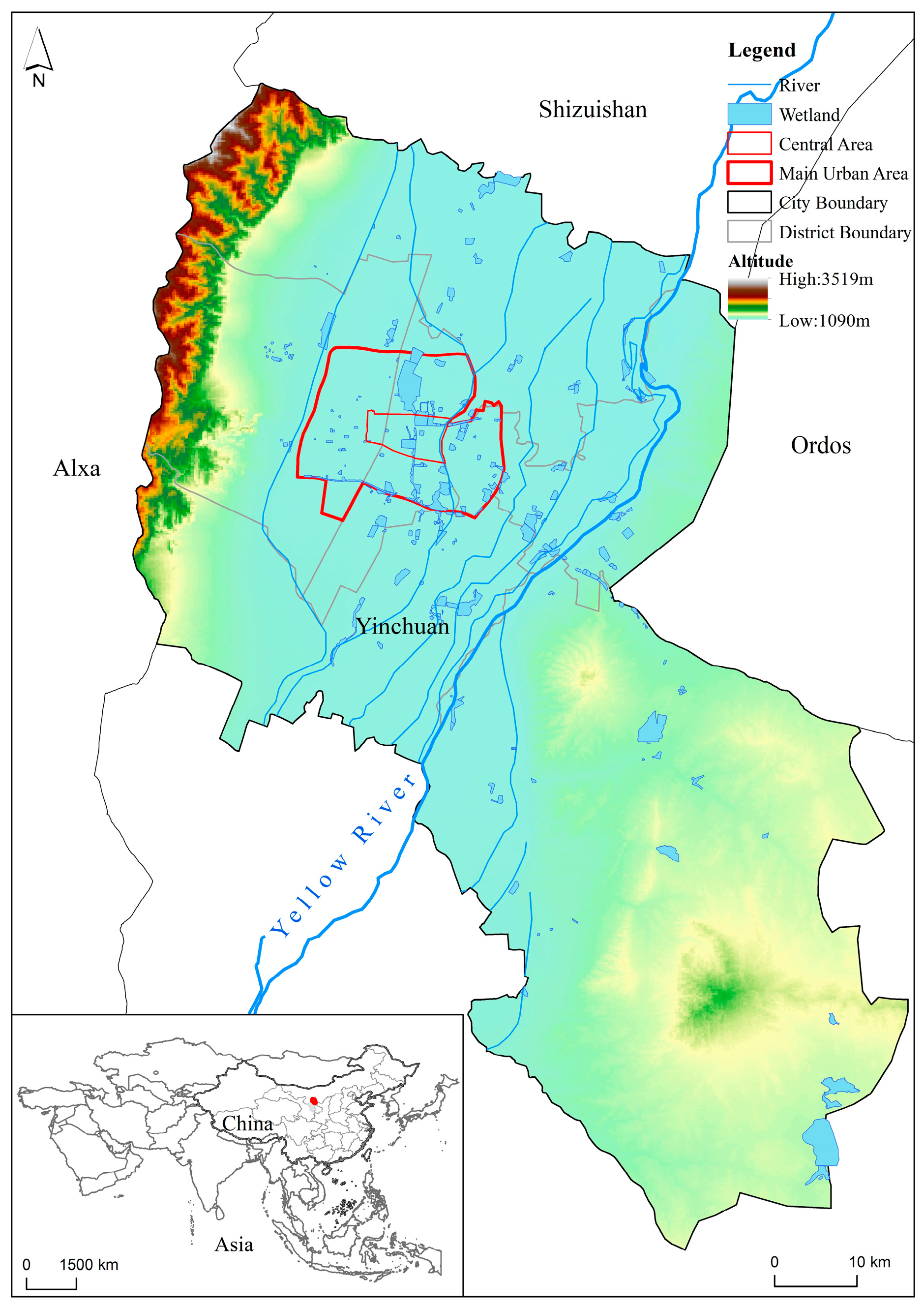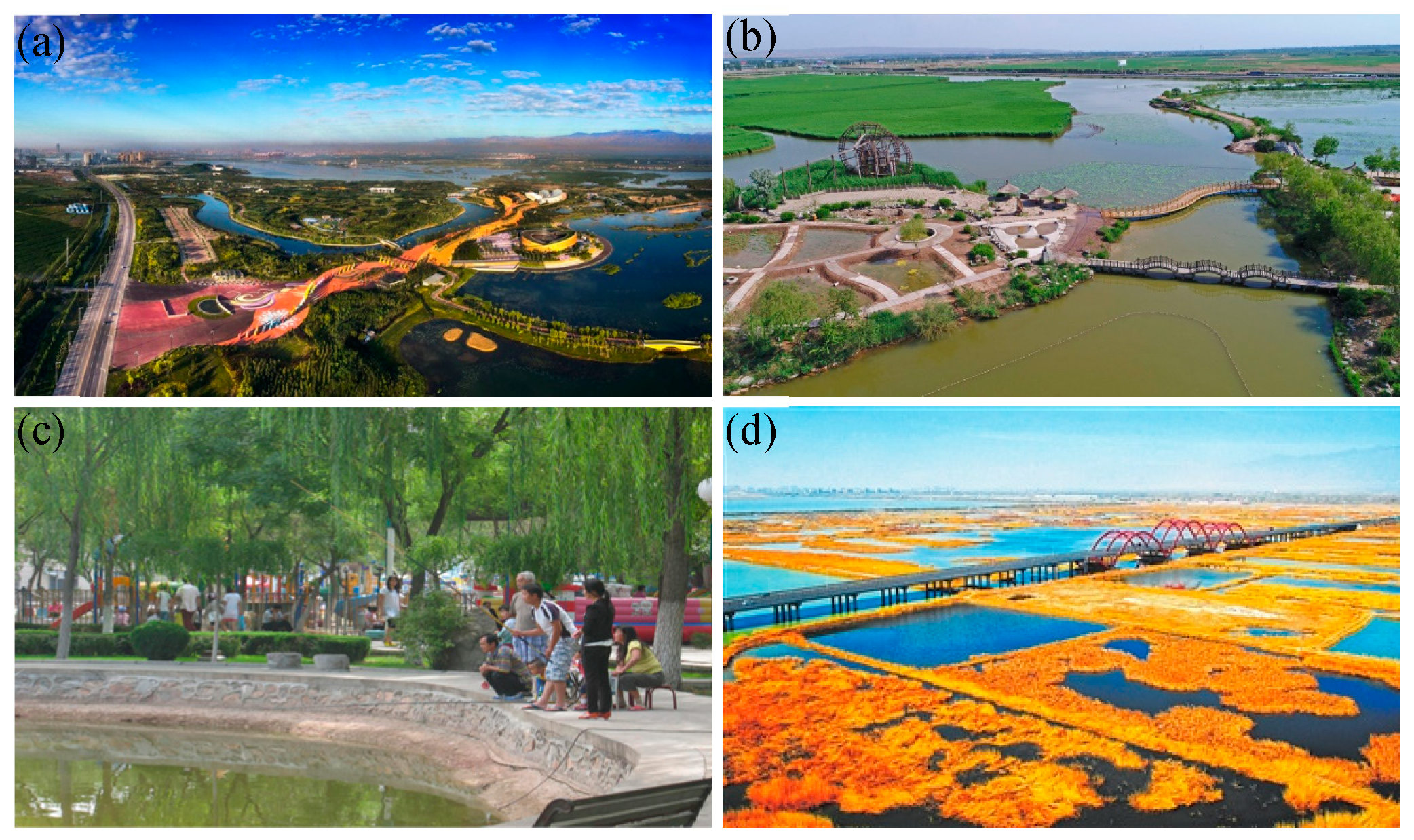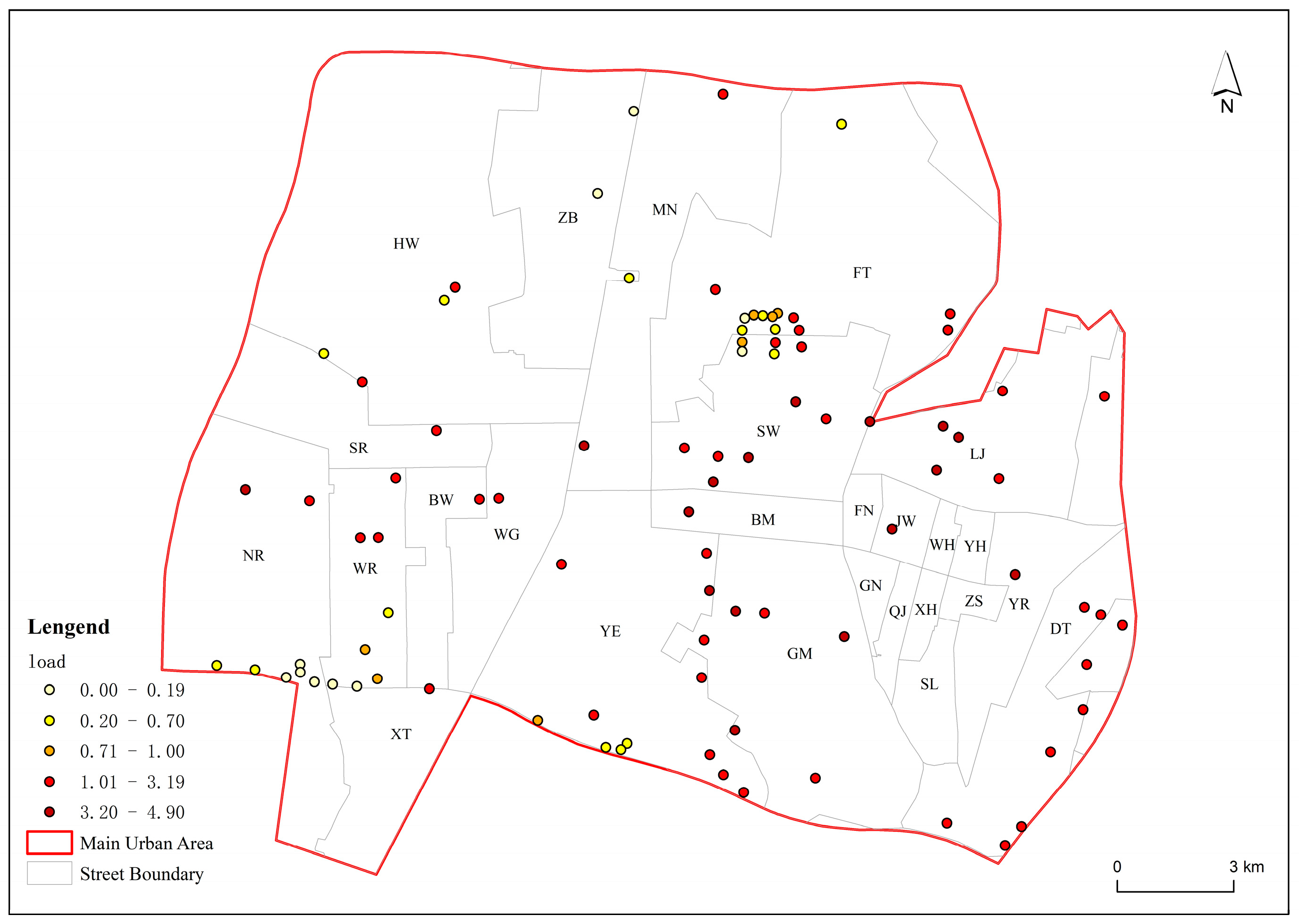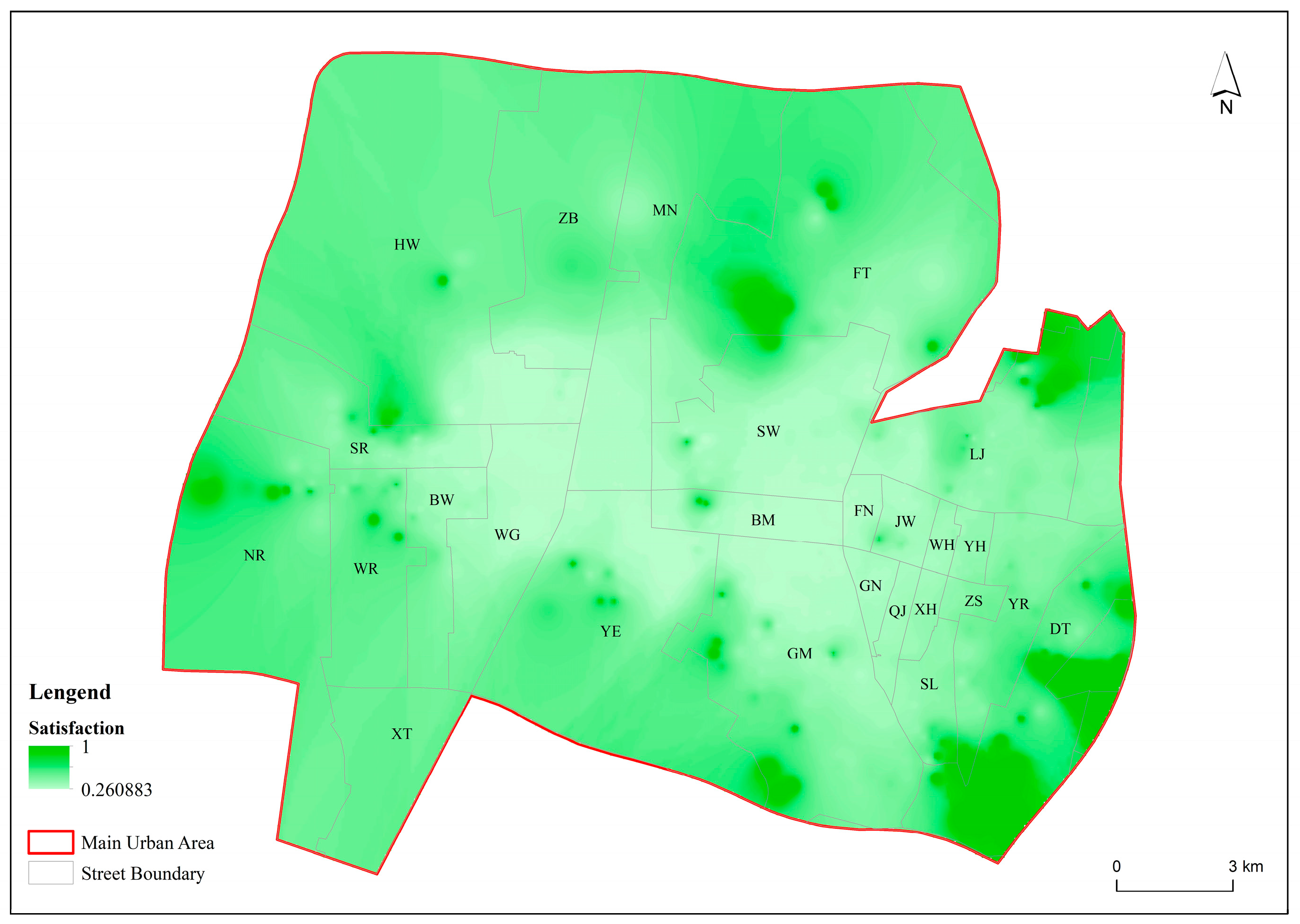Low Residents’ Satisfaction with Wetland Leisure Demand in Typical Urban Areas of the Semi-Arid Region in Western China: Spatial Variations and Their Causes
Abstract
1. Introduction
2. Materials and Methods
2.1. Case Study Area
2.2. Wetland Data
2.3. Population Data
2.4. Road Data
2.5. Measuring Residents’ Satisfaction with Wetland Leisure Demand
2.6. Spatial Load of Wetland Leisure Resources
2.7. Exploring Spatial Variations in Residents’ Satisfaction and Their Causes
3. Results
3.1. Spatial Differences in Wetland Load of Residents’ Leisure Demand
3.2. Residents’ Satisfaction with Wetland Leisure Demand and Its Spatial Heterogeneity
3.3. The Dominant Factors of Spatial Differences in Residents’ Satisfaction
4. Discussion
5. Conclusions
Author Contributions
Funding
Data Availability Statement
Acknowledgments
Conflicts of Interest
References
- Gong, P.; Niu, Z.; Cheng, X.; Zhao, K.; Zhou, D.; Guo, J.; Liang, L.; Wang, X.; Li, D.; Huang, H.; et al. China’s wetland change (1990–2000) determined by remote sensing. Sci. China Earth Sci. 2010, 53, 1036–1042. [Google Scholar] [CrossRef]
- Mao, D.; Wang, Z.; Du, B.; Li, L.; Tian, Y.; Jia, M.; Zeng, Y.; Song, K.; Jiang, M.; Wang, Y. National wetland mapping in China: A new product resulting from object-based and hierarchical classification of landsat 8 OLI images. ISPRS J. Photogramm. Remote Sens. 2020, 164, 11–25. [Google Scholar] [CrossRef]
- Ampatzidis, P.; Kershaw, T. A review of the impact of blue space on the urban microclimate. Sci. Total Environ. 2020, 730, 139068. [Google Scholar] [CrossRef] [PubMed]
- Hernández-Morcilloa, M.; Plieninger, T.; Bieling, C. An empirical review of cultural ecosystem service indicators. Ecol. Indic. 2013, 29, 434–444. [Google Scholar] [CrossRef]
- Peng, K.; Jiang, W.; Wang, X.; Hou, P.; Wu, Z.; Cui, T. Evaluation of future wetland changes under optimal scenarios and land degradation neutrality analysis in the Guangdong-Hong Kong-Macao Greater Bay Area. Sci. Total Environ. 2023, 879, 163111. [Google Scholar] [CrossRef] [PubMed]
- Enoh, M.A.; Okeke, U.C.; Nkechi, B.C. Mapping and simulating the spatial-temporal changes in the Lagos wetland ecosystem: A step-by-step approach to creating a carbon-neutral, sustainable urban city. Ecol. Model. 2023, 482, 110399. [Google Scholar] [CrossRef]
- Liao, R.K.; Jin, Z.Y.; Chen, M.H.; Li, S.Q. An integrated approach for enhancing the overall performance of constructed wetlands in urban areas. Water Res. 2020, 187, 116443. [Google Scholar] [CrossRef]
- Zhang, D.; Li, Z.; Zhong, J.; Yang, J. A framework for prioritizing urban ecological infrastructure (UEI) implementation tasks based on residents’ ecological demands and government policies. J. Environ. Manag. 2024, 354, 120369. [Google Scholar] [CrossRef] [PubMed]
- Zhu, X.; Lin, L.; Yang, Y.; Yuan, J.; Shi, Y. Construction status and distribution characteristics of national important wetlands in China. Environ. Prot. Sci. 2023, 50, 67–73. [Google Scholar] [CrossRef]
- Wang, P.W.; Han, L.R.; Mei, R. An Impact Asymmetry Analysis of Small Urban Green Space Attributes to Enhance Visitor Satisfaction. Int. J. Environ. Res. Public Health 2022, 19, 2922. [Google Scholar] [CrossRef]
- Ning, X. Review of Urban Public Space Researches from Multidisciplinary Perspective. Landscape 2021, 28, 52–57. [Google Scholar] [CrossRef]
- Gunawardena, K.R.; Wells, M.J.; Kershaw, T. Utilising green and bluespace to mitigate urban heat island intensity. Sci. Total Environ. 2017, 584, 1040–1055. [Google Scholar] [CrossRef] [PubMed]
- Tao, P.; Kuang, W.; Hua, S.; Zhang, C.; Wang, X.; Wang, X. Urban expansion and intra-urban land evolution as well as their natural environmental constraints in arid/semiarid regions of China from 2000–2018. J. Geogr. Sci. 2023, 33, 1419–1441. [Google Scholar] [CrossRef]
- Sun, K.; Yu, W.A. Satellite view of the wetland transformation path and associated drivers in the greater bay area of China during the past four decades. Remote Sens. 2024, 16, 1047. [Google Scholar] [CrossRef]
- Rao, Y.; Zou, Y.; Luo, F.; Yi, C.; Du, P.; Wu, P.; Lv, C. Subjective and objective accessibility of green parks in Fuzhou based on two-step floating catchment area method. Acta Ecol. Sni. 2024, 44, 4064–4080. [Google Scholar] [CrossRef]
- Wang, M.; Pei, X.; Zhang, M.; Tang, Y. Evaluation and optimization of urban public space accessibility for residents’ satisfaction: A case study of Nanshan district, Shenzhen city. Buildings 2023, 13, 2624. [Google Scholar] [CrossRef]
- Chen, L.; Jiang, Y.Z. Application of social satisfaction survey in city health examination evaluation. Sci. Geogr. Sin. 2021, 41, 1729–1741. [Google Scholar] [CrossRef]
- Boyce, M.R. Urban green infrastructure and pandemic response: How urban parks were used to support the COVID-19 response and the relationship between parkland acreage and excess mortality in large cities in the United States of America. Oxf. Open Infrastruct. Health 2024, 2, ouae001. [Google Scholar] [CrossRef]
- Chai, Y.W.; Zhang, X.; Sun, D. A study on life circle planning based on space time behavioral analysis: A case study of Beijing. Urban Plan. Forum 2015, 3, 61–69. [Google Scholar] [CrossRef]
- Sun, D.F.; Shen, S.; Wu, T.H. Life circle theory based county public service distribution: Jiangsu pizhou case. Planners 2012, 28, 68–72. [Google Scholar]
- Pang, J.; Jin, L.; Yang, Y.; Li, H.; Chu, Z.; Ding, F. Policy cognition, household income and farmers’ satisfaction: Evidence from a wetland ecological compensation project in the Poyang lake area at the micro level. Sustainability 2022, 14, 10955. [Google Scholar] [CrossRef]
- Das, A.; Basu, T. Assessment of peri-urban wetland ecological degradation through importance-performance analysis (IPA): A study on Chatra Wetland, India. Ecol. Indic. 2020, 114, 106274. [Google Scholar] [CrossRef]
- Wu, X.; Bu, X.; Dong, S.; Ma, Y.; Ma, Y.; Ma, Y.; Liu, Y.; Wang, H.; Wang, X.; Wang, J. The impact of restoration and protection based on sustainable development goals on urban wetland health: A case of Yinchuan plain urban wetland ecosystem, Ningxia, China. Sustainability 2023, 15, 12287. [Google Scholar] [CrossRef]
- Gao, Z.; Guo, H.; Li, S.; Wang, J.; Ye, H.; Han, S.; Cao, W. Remote sensing of wetland evolution in predicting shallow groundwater arsenic distribution in two typical inland basins. Sci. Total Environ. 2022, 806, 150496. [Google Scholar] [CrossRef] [PubMed]
- Chen, Y.; Jia, S.; Xu, Q.; Xiao, Z.; Zhang, S. Measuring the dynamic accessibility to COVID-19 testing sites in the 15-min city: A focus on service congestion and mobility difference. J. Transp. Geogr. 2023, 111, 103670. [Google Scholar] [CrossRef]
- Sun, J.N.; Jiang, K. Application of GIS spatial analysis in urban ecological planning: Taking Yinchuan ecological planning as an example. Constr. Sci. Technol. 2021, 08, 60–65. [Google Scholar] [CrossRef]
- Tan, C.; Yang, J.; Wang, X.; Qin, D.; Huang, B.; Chen, H. Drought disaster risks under CMIP5 RCP scenarios in Ningxia Hui Autonomous Region, China. Nat. Hazards 2020, 100, 909–931. [Google Scholar] [CrossRef]
- Wang, X.; Hu, G.; Saito, Y.; Ni, G.; Hu, H.; Yu, Z.; Chen, J.; Wang, M.; Yuan, X.; Wang, L.; et al. Did the modern Yellow River form at the Mid-Pleistocene transition? Sci. Bull. 2022, 67, 1603–1610. [Google Scholar] [CrossRef] [PubMed]
- Wang, X.; Jiang, W.; Peng, K.; Li, Z.; Rao, P. A framework for fine classification of urban wetlands based on random forest and knowledge rules: Taking the wetland cities of Haikou and Yinchuan as examples. GIScience Remote Sens. 2022, 59, 2144–2163. [Google Scholar] [CrossRef]
- Shao, N.; Liu, X.; Qu, X. Valuation of lake wetland ecosystem services of Yinchuan City. Chin. J. Ecol. 2008, 9, 1625–1630. [Google Scholar]
- Wang, M.; Mao, D.; Wang, Y.; Xiao, X.; Xiang, H.; Feng, K.; Luo, L.; Jia, M.; Song, K.; Wang, Z. Wetland mapping in East Asia by two-stage object-based Random Forest and hierarchical decision tree algorithms on Sentinel-1/2 images. Remote Sens. Environ. 2023, 297, 113793. [Google Scholar] [CrossRef]
- Mao, Q.; Wang, L.; Guo, Q.; Li, Y.; Liu, M.; Xu, G. Evaluating cultural ecosystem services of urban residential green spaces from the perspective of residents’ satisfaction with green space. Front. Public Health 2020, 8, 226. [Google Scholar] [CrossRef] [PubMed]
- Esch, T.; Zeidler, J.; Palacios-Lopez, D.; Marconcini, M.; Roth, A.; Mönks, M.; Leutner, B.; Brzoska, E.; Metz-Marconcini, A.; Bachofer, F.; et al. Towards a large-scale 3D modeling of the built environment—Joint analysis of TanDEM-X, Sentinel-2 and Open Block Map fata. Remote Sens. 2020, 12, 2391. [Google Scholar] [CrossRef]
- Breiman, L. Random forests. Mach. Learn. 2001, 45, 5–32. [Google Scholar] [CrossRef]
- Chen, H.; Ou, X.; Lv, Y.; Lv, X.; Zheng, X. Priority conservation pattern of wetlands in Beijing from the perspective of time and space. Acta Ecol. Sin. 2024, 44, 1–12. [Google Scholar] [CrossRef]
- Hao, F.L.; Zhang, H.R.; Wang, S.J. Spatial accessibility of urban green space in central area of Changchun: An analysis based on the multi-trip model. Sci. Geogr. Sin. 2021, 41, 695–704. [Google Scholar] [CrossRef]





| Age Groups | 0–20 | 21–59 | >60 |
|---|---|---|---|
| Proportion | 21.57% | 65.64% | 12.79% |
| Willingness to travel (times/week) | 0.7996 | 1.2916 | 3.825 |
| Levels of Residents’ Satisfaction | Total Population of Communities | Road Traffic Capacity | Wetland Area | R2 |
|---|---|---|---|---|
| Relatively low | 20% | 27% | 52% | 0.50 |
| Relatively medium | 32% | 37% | 31% | 0.32 |
| Relatively high | 25% | 35% | 40% | 0.50 |
Disclaimer/Publisher’s Note: The statements, opinions and data contained in all publications are solely those of the individual author(s) and contributor(s) and not of MDPI and/or the editor(s). MDPI and/or the editor(s) disclaim responsibility for any injury to people or property resulting from any ideas, methods, instructions or products referred to in the content. |
© 2024 by the authors. Licensee MDPI, Basel, Switzerland. This article is an open access article distributed under the terms and conditions of the Creative Commons Attribution (CC BY) license (https://creativecommons.org/licenses/by/4.0/).
Share and Cite
Zhang, Z.; Zeng, B. Low Residents’ Satisfaction with Wetland Leisure Demand in Typical Urban Areas of the Semi-Arid Region in Western China: Spatial Variations and Their Causes. Land 2024, 13, 777. https://doi.org/10.3390/land13060777
Zhang Z, Zeng B. Low Residents’ Satisfaction with Wetland Leisure Demand in Typical Urban Areas of the Semi-Arid Region in Western China: Spatial Variations and Their Causes. Land. 2024; 13(6):777. https://doi.org/10.3390/land13060777
Chicago/Turabian StyleZhang, Ziyu, and Biao Zeng. 2024. "Low Residents’ Satisfaction with Wetland Leisure Demand in Typical Urban Areas of the Semi-Arid Region in Western China: Spatial Variations and Their Causes" Land 13, no. 6: 777. https://doi.org/10.3390/land13060777
APA StyleZhang, Z., & Zeng, B. (2024). Low Residents’ Satisfaction with Wetland Leisure Demand in Typical Urban Areas of the Semi-Arid Region in Western China: Spatial Variations and Their Causes. Land, 13(6), 777. https://doi.org/10.3390/land13060777







